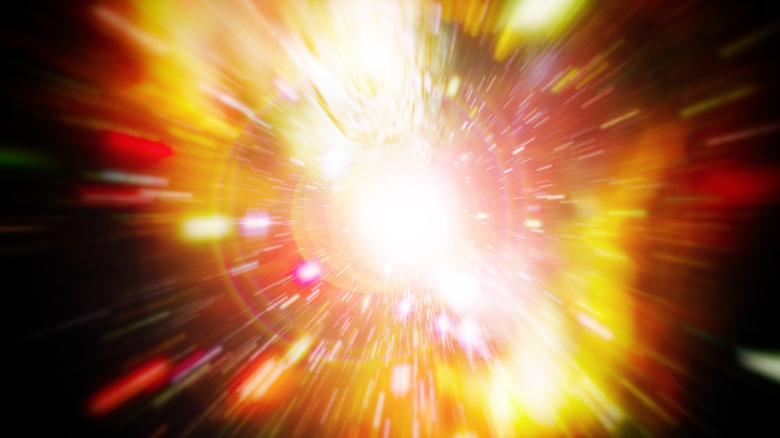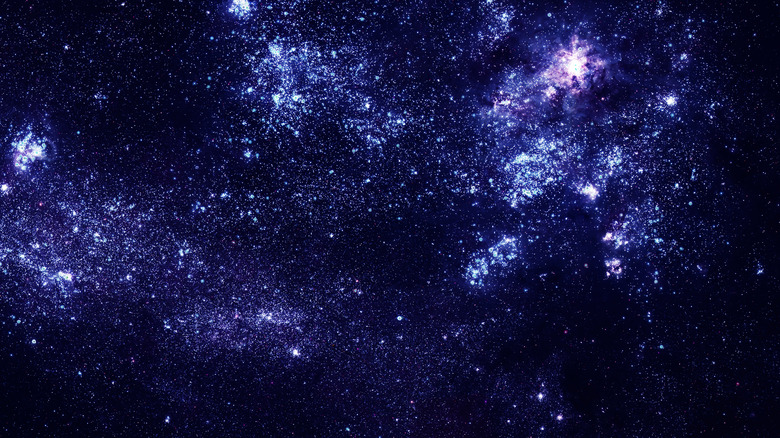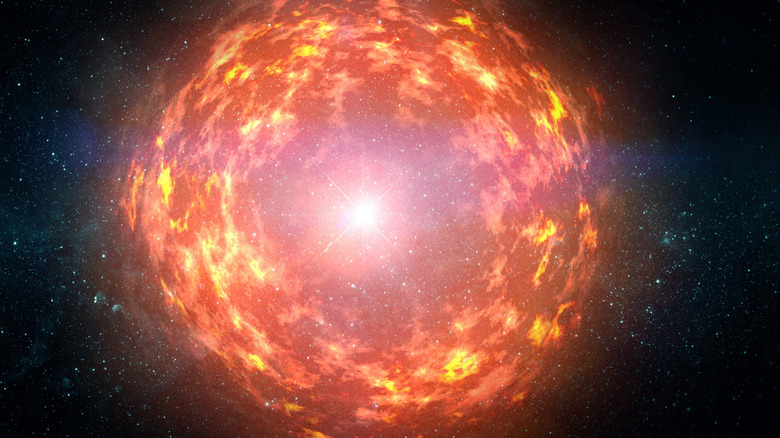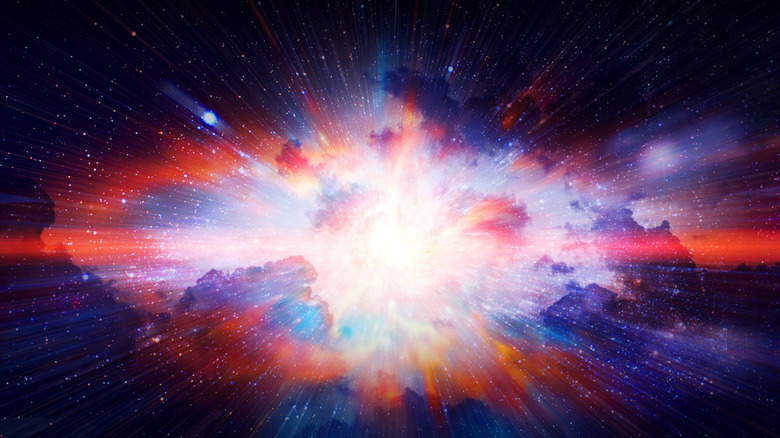The Substance That Might Have Existed Before The Big Bang
Like the question of what is outside outer space, the question of what existed before the Big Bang, which took place 14 billion years ago, is one of the most perplexing mysteries facing humanity. In a 2017 talk, physicist David Tong put it like this: "This name, 'Big Bang,' it's very misleading. When you hear the word 'Big Bang' [...] what you should hear is, 'We have no idea whatsoever what's happening here'." Physicists simply don't know what was happening at the single moment just before the universe began to exist, otherwise known as the singularity. As Tong went on to say, "We don't really know if there is a 'before' the bang."
The singularity, which is also used to refer to the area at the center of a black hole, is a point at which large amounts of matter are compacted into infinitely small space — a place smaller than a subatomic particle where the volume of space is zero and there is infinite density. It's from this singularity that our universe is thought to have exploded, but prior to that explosion we simply don't know what, if anything, existed.
Several theories have been offered on this subject, however. Back in 2008, physicists studying the studying the cosmic microwave background (CMB), which refers to leftover radiation from the Big Bang which is still observable today, claimed that fluctuations in the CMB suggested that our universe "bubbled off" from a previous one. In a 2018 paper published in Physical Review Letters, researchers Latham Boyle, Kieran Finn, and Neil Turok proposed that there was a mirror image of our universe that pre-existed the Big Bang. In recent decades there has also been new research that suggests there was actually a moment between the singularity and the Big Bang. Now, researchers have put forward a model that proposes this in-between moment actually produced dark matter.
What came before the Big Bang?
Despite our ongoing ignorance as to what happened at the moment of — and prior to — the Big Bang, we do have a remarkably good understanding of what happened in the moments after it occurred. The fact we know the universe is expanding, for instance, is what allows us to trace that expansion backward to a time when the cosmos was packed into the point of singularity. We also know that the temperature of the universe at the time of the Big Bang was 18 × 10³¹ degrees Fahrenheit, which is a staggering fact in and of itself. But perhaps even more staggering is the thought of what might have pre-existed the Big Bang.
If the Big Bang was the beginning of our universe, how could anything pre-exist it? In order to answer that question, we need to look at how our understanding of the Big Bang has evolved in recent years. The Big Bang theory posits that the Universe began with the singularity 13.8 billion years ago and rapidly expanded from a small, hot, and dense state, becoming cooler and less dense as it continued to expand ultimately becoming the cosmos we see today.
But recent years have seen scientists come to embrace a theory that suggests there was another stage in the process that birthed our universe: an extremely short moment that lasted for a fraction of a second during which the universe expanded faster than the speed of light.
Cosmic inflation theory suggests a time before the Big Bang
To understand how something could possibly exist prior to the Big Bang, it's important to familiarize ourselves with another theory: cosmic inflation. This is the idea that there was actually a state between the singularity and the Big Bang itself. First developed in the early 1980s by physicists such as Alan Guth, Alexei Starobinsky, Andrei Linde, and Katsuhiko Sato, the theory proposes that there was actually a very brief moment of exponential expansion prior to what we think of as the Big Bang, and this extremely short period of time is actually responsible for the temperature imperfections we can now observe in the Big Bang's afterglow — the cosmic microwave background.
Research conducted in the past two decades has seemingly confirmed that there was indeed a pre–Big Bang moment of rapid inflation. This research revealed the existence of what are known as super-horizon fluctuations, which without going into too much more detail, essentially make it so that the singularity-to-Big Bang model doesn't match the universe as we're able to observe it today. In order to explain these super-horizon fluctuations, we need the cosmic inflation model, which explains these fluctuations as remnants of the pre–Big Bang rapid expansion.
With that out of the way, we can start to imagine how dark matter might pre-exist the Big Bang.
Dark matter, the mysterious substance that may have pre-existed the Big Bang
Dark matter is yet another gigantic mystery that physicists haven't yet solved. First implicated by one of Albert Einstein's major breakthroughs, the general theory of relativity, dark matter is so mysterious we're yet to officially see it, despite the fact it makes up roughly 85% of all the matter in the universe. Thus far, we've only been able to infer its existence based upon its effects, specifically the way galaxies rotate.
The term "matter" refers to substances that have mass and occupy space, and while dark matter also takes up space and holds mass, it doesn't reflect, absorb, or radiate light in any way that would allow us to detect it. Today, we still don't know what particles make up dark matter, and now it seems the substance has become even more mysterious as it appears to have pre-existed the Big Bang.
Published in Physical Review Letters, a 2024 paper authored by three scientists from the University of Texas, Austin proposes a model known as warm inflation via ultraviolet freeze-in, or WIFI, to suggest that dark matter was created much earlier than previously thought and was actually formed just before the Big Bang during the cosmic inflation stage. Researchers Katherine Freese, Gabriele Montefalcone, and Barmak Shams Es Haghi led the study, with Freese explaining in a media release (via MSN), "In most models, anything that is created during inflation is then 'inflated away' by the exponential expansion of the universe, to the point where there is essentially nothing left." But the researchers' WIFI model suggests that the dark matter, which we know makes up such a huge proportion of our universe, was actually created during the cosmic inflation stage through tiny interactions within an incredibly hot and energetic environment.
The WIFI model could have major implications in future
The UT Austin study is quite complex in terms of the mechanisms it proposes for the creation of dark matter during cosmic inflation. The researchers used mathematical modeling to suggest that, in this inflation phase, radiation was produced, creating a thermal bath which allowed for interactions to take place that resulted in the production of dark matter particles. This process is called freeze-in, and involves a field of hypothetical particles called inflatons. This is where the model delves into quantum field theory, which suggests that at the very deepest subatomic level, beyond the realm of particles, the universe is made up of fluid-like fields of substances. In the WIFI model, the inflaton field (the theoretical driver of inflation) is said to lose energy to radiation in the thermal bath during the cosmic inflation period, producing dark matter particles.
This model is noteworthy not only for its suggestion that dark matter pre-existed the Big Bang, but also for its suggestion that this WIFI mechanism is efficient enough to produce far more dark matter than conventional models.
While the proposals in the study are yet to be confirmed, the authors are optimistic that their predictions will be borne out in future research. If the mathematical modeling in the study does turn out to be correct, it will represent a revolution in our understanding on dark matter and its origins, as well as matter creation more generally and the evolution of our universe as a whole. As Shams Es Haghi put it in the media release, "In our study, we focused on the production of dark matter, but WIFI suggests a broader applicability such as the production of other particles that could play a crucial role in the early universe's evolution. This highlights new opportunities for exploration in future research."




